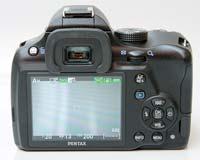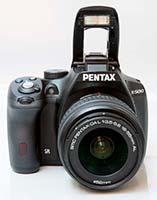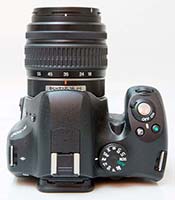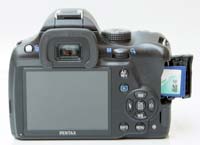
Buy a K-500 Black SLR Digital Camera Kit w/ 18-55 mm Lens (16.28 MP, SD/SDXC/SDHC Card Slot)
Buy a K-500 Digital SLR Camera, Black, with Black DA L 18-55mm Zoom Lens
Introduction
The Pentax K-500 is a new entry-level DSLR camera. Key features include an ISO range of 100-51200, Full HD 1080p video at 30, 25 and 24fps, 6fps continuous shooting, 11-point SAFOX IX+ AF system, High Dynamic Range mode, and a range of in-built digital filter effects. The K-500 also offers a shutter designed for 100,000 releases, top shutter speed of 1/6000th second, optical viewfinder with nearly 100% frame coverage, 77-segment matrix meter, 3-inch LCD monitor with 920k dots, built-in dust removal and shake-reduction systems, Live View with Face Recognition AF, automatic compensation of lens distortion and lateral chromatic aberrations with DA and DFA lenses, Eye-Fi card support for wireless transmission of images, and a choice of lithium-ion or AA batteries. The Pentax K-500 is available in black, priced at £449.99 / $599.95 for the kit with the 18-55mm DA-L lens. In the US the K-500 will also be available in a dual lens kit including the DA-L 18-55mm and DA-L 50-200mm lenses for $699.95.
Ease of Use
The Pentax K-50 is essentially the same camera as the more expensive K-50 model, sacrificing the weather-proofness of that camera and its accompanying kit lens to hit a lower price point. Therefore a lot of the comments that we made about the K-50 apply equally to the cheaper K-500.
The Pentax K-500′s control layout is very similar to its older big brother, the K-30, although the more “extreme” styling of that camera has been replaced with a more traditional look and feel. The Pentax K-500 is identical in size – 96.5(H) x 129(W) x 70(D) – and weight – 590g without the battery or memory card fitted. Despite its all-plastic construction the K-500 feels pretty solid. The smc PENTAX-DA 18-55mm F3.5-5.6 AL kit lens is better built than the kits lenses of its rivals, although it’s a rather slow lens at both ends of the focal length (f3.5-5.6).
The K-500 is quite a complex camera in terms of functionality and the number of external controls that it offers, with 19 in total and a lot of them having more than one function. Despite the presence of so many buttons and switches, the Pentax K-500 doesn’t feel too cluttered or intimidating, although it will certainly take some time to adapt to for people moving up from a simpler entry-level SLR.
Departing from the recent trend of ultra-compact SLR models, the K-500 is definitely designed for “normal” hands. The camera has a deep, contoured handgrip on the right-hand side, coated in a rubberized compound to aid grip, that enabled us to use three fingers to hold it and a right forefinger to operate the shutter button. There is a generous contoured area where your right thumb sits, although disappointingly it’s not covered in the same coating as the front handgrip. Curiously the left-hand side (viewed from the rear) and the remote control port on the right also have a rubber covering, with the rest of the body finished in a shiny black.
On the front of the camera body is the RAW / FX button, which instantly sets the image quality to the RAW format, useful if you are shooting in JPEG and want to quickly switch to RAW mode for a particular image. This button can also be customised to optionally control either Exposure Bracketing, Optical Preview, Digital Preview, Composition Adjustment or AF Active Area. Located underneath is the Autofocus Mode switch, with three available modes, and above a small button for opening the pop-up flash, which extends quite high above the lens to help minimise red-eye.
On the bottom of the K-500 is the battery compartment, interestingly housing either the supplied rechargeable 1050mAh lithium-ion battery or 4 AA batteries. You get the versatility of choosing between two different power sources, but the low power lithium-on battery only offers a rather mediocre performance of around 480 shots before being depleted. There’s also a metal tripod mount that’s perfectly in-line with the centre of the lens mount.
On the right-hand side of the K-500 is the SD / SDHC memory card slot, and located below is the remote cable release connector. On the left-hand side is a vertical flap covering the PC port. Note that the Pentax K-500 still doesn’t have an HDMI port, a disappointing omission.
The Pentax K-500 has a shooting mode dial on the top-right of the camera which allows you to select either one of the advanced mode like Aperture-priority, Shutter-Priority and Manual, or the more point-and-shoot Auto and Program modes. There are also a range of 19 scene modes, signaling its intent as a camera that’s equally suited to more casual users. You’ll instantly notice that the K-500 has a couple of unusual shooting modes that you won’t have seen before on any other camera (apart from older Pentax DSLR models). These are the Sensitivity-Priority and Shutter Aperture-Priority modes, and they are genuinely useful additions.


Front
Rear
Sensitivity-Priority automatically selects the best combination of aperture and shutter speed for your chosen ISO speed. The sensitivity can be shifted instantly (in 1/2 or 1/3 steps) by turning the rear control dial. This allows you to quickly select an ISO speed, without having to access the menu system, which is very useful in rapidly changing light conditions. In Shutter Aperture-Priority mode the camera selects the most appropriate ISO speed for a shutter speed and aperture combination, allowing you to use ISO sensitivity as a third factor in determining the correct exposure. As digital cameras have always offered the unique ability to instantly change the sensitivity, it’s surprising that Pentax are still the only manufacturer to allow you to use ISO in this way.
Also on the right hand side of the top of the K-500 is the small shutter button, surrounded by the on/off switch. Located in front of the shutter button is one of the e-dials, predominately used to change the shutter speed, while behind it are the Exposure Compensation button and a rather innocuous looking button with a small green dot that’s unique to Pentax DSLRs. It has two uses – firstly, when shooting in Manual mode, a single push of the green button allows you to instantly set the correct exposure for the subject, as calculated by the camera, useful if you need a starting point for your own exposure. Secondly, the K-500 offers a Hyper Program function which instantly switches to either the Shutter-Priority or Aperture-Priority mode from the Program mode, simply by turning either of the control dials on the grip. Pressing the Green button then returns to the Program mode.
The Pentax K-500 has a traditional eye-level optical TTL viewfinder which offers an impressive 100% scene coverage. Being able to see exactly what will be captured means that you can only blame yourself for poor composition and unwanted details creeping into the frame. The viewfinder is bright and free of any distortions or aberrations, making it suitable for both auto and manual focusing. It also features an interchangeable Natural-Bright-Matte III focusing screen to improve focusing accuracy during manual-focus operation. The in-finder status LCD runs horizontally along the bottom and it shows most of the camera’s key settings.
The rear of the camera is dominated by the large 3 inch LCD screen. The K-500′s LCD screen has a very high resolution of 920K dots, wide viewing angle and it remains visible outdoors in all but the brightest of conditions, making it one of the better LCD screens that we’ve seen on a DSLR. The colour temperature of the screen can be modified if you think it doesn’t match that of your calibrated computer monitor, but the contrast and gamma cannot be altered. The rear screen also doubles as a comprehensive status display, which can be called up by pressing the OK or Info buttons in record mode. If you then press the Info button again, you can also change all the settings right on the screen using a combination of the navigation pad and the rear e-dial. This ingenious solution spares you the pain of having to enter the menu, and makes most setting changes very simple.
Located above the LCD screen and to the left of the viewfinder is the shared Live View / Delete button. You can use the Live View mode to hold the K-500 at arm’s length or mount the camera on a tripod, with a single press of the LV button on the rear displaying the current scene on the LCD screen. Focusing is achieved by pressing the small AF button on the rear of the camera or by half-pressing the shutter-button. Alternatively you can use manual focus in Live View mode, with up to 10x magnification available via the Info button to help you fine-tune the focus (you can also use the Info button to magnify the subject by up to 6x when Auto Focus is on). Most of the main camera settings are displayed in Live View, although a histogram is conspicuous by its absence. You can change the aperture, shutter speed, exposure compensation, ISO speed and a number of other settings when Live View is activated.
Live View is fine for use with stationary subjects, but forget it if you want to track a moving subject. The AF system in Live View mode takes a couple of seconds to lock onto the subject, making it much better suited to subjects that don’t move. The Face Recognition AF mode works quite well, as promised quickly identifying up to 16 people in the frame, but again it takes a couple of seconds to lock onto a non-moving subject. More impressively Live View can be used in the continuous shooting mode with no restrictions on the 6fps rate, as the K-500 sets the mirror to the lock-up position.
Live View is also used for the feature that will generate a lot of interest in the Pentax K-500: its movie mode. The K-500 can record Full 1080p HD footage, recording high-definition video at either 1920 x 1280 pixels, 1280 x 720 pixels or 640 x 480 pixel at 30fps, 25fps or 24fps in the MOV format. The maximum size of a single video clip is either 4 gigabytes or 25 minutes. There’s a built-in microphone for mono recording. You can only connect the K-500 to a standard TV set via NTSC/PAL – there’s no HDMI port.


Pop-up Flash
Top
There are some notable drawbacks to the Pentax K-500′s video mode. It’s quite difficult to actually start recording one. You have to set the Mode Dial to the Movie mode, then press the AF-On or half-press shutter button to set the focus, then press the shutter button to begin recording (with the same button ending the movie). It’s not on a par with the one-button system that some rivals offer, and you can’t take a still shot during recording either. As with most modern DSLR cameras that offer a video mode, you can autofocus during movie recording, although it’s pretty slow and loud to do so with the standard kit lens. Unfortunately you still can’t set the camera to continually autofocus when shooting video, something that several newer DSLRs can now do.
To the right of the viewfinder is the rear e-dial, mainly used for changing the aperture, and the AF/AE-L button, handily placed for autofocusing and locking the exposure. Underneath is the traditional 4-way navigation pad which is split into separate buttons, providing instant access to the ISO speed, drive mode/self-timer, white balance and flash settings, with the OK button confirming actions.
The Menu button accesses all of the different menu options that the camera offers, reflecting the fact that this is quite a complex and customisable DSLR. Thankfully you will only have to set about half of the settings once and can then forget about them. The menu system has a fairly logical tabbed system with five main tabs, Record, Movie, Playback, Setup and Custom, each divided into several sub-pages, and it’s easily readable with a bright display and a large font size making it perfectly visible even in low light.
The Pentax K-500 features a built-in Shake Reduction system. Turn it on via the main menu option and the K-500 automatically compensates for camera shake, which is a slight blurring of the image that typically occurs at slow shutter speeds, providing approximately 2.5 to 4 shutter steps of compensation. As this system is built-into the camera body, it works with almost any lens that you attach to the K-500, providing a significant cost advantage over DSLRs from Canon and Nikon, which use a lens-based image stabilisation system (compatible lenses are the PENTAX K-, KA-, KAF-, KAF2- and KAF3-mount lenses; screw-mounted lenses (with an adapter); and 645- and 67-system lenses (with an adapter)).
In practice we found that it does make a noticeable difference, as shown in the examples on the Image Quality page. You don’t notice that the camera is actually doing anything different when Shake Reduction is turned on, just that you can use slower shutter speeds than normal and still take sharp photos. The K-500 also displays a blur icon in the viewfinder to warn you that camera-shake may occur, regardless of whether or not Shake Reduction is on.
If you’ve had a bad experience with DSLRs and dust in the past, then the K-500 offers a Dust Removal mechanism. This automatically shifts the low-pass filter located in front of the CMOS image sensor at very high speed, shaking the dust off the low-pass filter. If you do still notice any dust, there’s a neat feature called Dust Alert which is designed to show exactly where the dust is on the image sensor. A vertically and laterally correct image of the sensor shot at f/16 is shown on the LCD screen, indicate exactly where any stubborn dust particles may be lurking. While this feature won’t prevent dust from getting onto the sensor, it does provide a quick and easy way of checking for it. In addition Dust Removal can be set to activate whenever the camera is turned on, and you can also use the built-in Sensor Cleaning function to lift the mirror and clean the image sensor with a blower brush or third-party cleaning solution.
The Pentax K-500′s High Dynamic Range (HDR) Capture option (only available for JPEGs) takes three images with different exposures, with 4 different strengths on offer, and then records a single image that combines the properly exposed parts of each one, expanding its dynamic range. It’s important to always use a tripod to prevent camera shake from blurring the HDR image, and it doesn’t work very well for moving subjects.


Memory Card Slot
Battery Compartment
Similar to Nikon’s D-lighting, Sony’s DRO, and Olympus’ Shadow Adjustment Technology, Pentax’s D-Range allows you to correct the highlights (On or Off) and/or the shadows (3 different levels) before taking a JPEG or RAW image. Although this option is always at your disposal, remember that it is meant to be used in strong, contrasty lighting at base ISO. The Pentax K-500 also has a multi exposure mode that allows you to combine between two and nine different JPEG or RAW images into a single photo.
Pentax’s Custom Images, similar to Nikon’s Picture Styles and Canon’s Picture Controls, are preset combinations of different sharpness, contrast, saturation and colour tone settings. You can change the saturation, hue, high/low key, contrast and sharpness for each of the eleven optionsâ€. The Pentax K-500 additionally offers seven different Digital Filters, which allow you to quickly apply an artistic effect to a photo before taking it (JPEG images only). Note that applying the Digital Filters slows the camera down somewhat, as it has to process the image for a few seconds after it’s taken. The K-500 can also be set to automatically compensate for both distortion and lateral chromatic aberration of any DA- and DFA-series lenses.
The rather innocuous-sounding AF Fine Adjustment custom function will be of particular interest to current Pentax owners. If you have a collection of older Pentax lenses and you’ve never been quite sure how accurate they focus when mounted on a DSLR, this is the function for you. Essentially it allows you to alter the focus of each Fine Adjustment option, then test again until perfect focus is achieved. With most other DSLR systems you’d have to send the camera and lens off for calibration (and maybe even have to pay for it), but with the K-500, you can calibrate all of your lenses in the comfort of your own home.
The start-up time of the Pentax K-500, from turning the camera on to being ready to take a photo, is very quick at around 1 second. Focusing is also quick and consistent in good light with the standard 18-55mm kit lens, with the 11 point SAFOX IXi+ AF system offering generous scene coverage and 9 cross-type sensors, and the camera happily achieves focus indoors and in low-light situations. Note that the 18-55mm lens has an annoyingly loud focusing mechanism though. The powerful AF Assist lamp can be used even if the built-in flash isn’t raised, and there’s a very handy peaking function that’s great for manual focus users (although annoyingly it doesn’t work for video as well as stills).
It takes about 1 second to store a JPEG image at the highest quality setting with no discernible lockup between taking shots, allowing you to keep shooting as they are being recorded onto the memory card. For RAW images the Pentax K-500 takes about 2 seconds to store an image and again there is no lockup between shots. In the continuous shooting mode you can hold down the shutter button and take 6 shots per second for up to 30 JPEG or 8 RAW files. The camera does lock up for a few seconds once the maximum number of shots is reached, although you can continue to shoot continuously, just at a much slower rate.
Once you have captured a photo, the Pentax K-500 has a good range of options for playing, reviewing and managing your images. You can instantly scroll through the images that you have taken, view 9 thumbnails, zoom in and out up to a magnification of 16x, and see very detailed information about each image by pressing the Info button. You can also delete, rotate, resize, protect and crop an an image, view a slideshow and set various printing options. There are an expanded range of 19 digital effects available which can be applied to JPEGs plus a Custom option to create your own unique effect. The camera shows you a preview of what the effect will look like when applied, and the effect is applied to a copy of your image, thus preserving the original intact.
The Index option creates an index print from up to 36 images, Save as Manual WB sets the camera’s Manual White Balance setting to the colour balance of the current image, and RAW Development converts a RAW file into a JPEG or TIFF with various conversion parameters available. Movie Editing lets you divide or extract segments from your movies. Importantly the Pentax K-500 offers a histogram after taking a photo which is a great help in evaluating the exposure, plus any areas that are over-exposed flash on and off in the LCD preview to show you want you should be compensating for with your next attempt. If you have never used a digital camera before, or you’re upgrading from a more basic model, reading the comprehensive but relatively easy-to-follow manual before you start is a good idea. Thankfully Pentax have chosen to supply it in printed format, rather than as a PDF on a CD, so you can also carry it with you for easy reference.
Share this review
If you enjoyed this review, please help spread the word by tweeting it on
Twitter or liking it on Facebook.
Compare UK Prices
Support PhotographyBLOG: Buy the Pentax K-500 from
one of our affiliate UK retailers:
Compare Prices
Support PhotographyBLOG: Buy the Pentax K-500 from
one of our affiliate retailers:
Entry Tags
hd video,
hd,
3 inch LCD,
1080p,
16 megapixel,
beginner,
full hd,
DSLR,
pentax,
digital SLR,
6fps,
entry,
Pentax K-500 Review,
k-500,
k500,
k500 review
Pentax K-500 Review
No comments:
Post a Comment